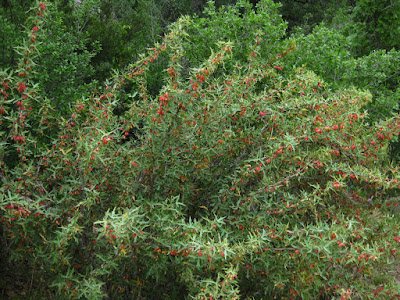Landscaping with Native Plants
The majority of Hays County is in the Edwards Plateau ecosystem. When European settlers arrived in the mid-1800s, the area was a patchwork of grassland savannahs and woodland stands of juniper and oak which supported large herds of bison, deer and antelope.
Introduction of livestock and non-native plants and grasses, as well as construction and farming, have dramatically changed the area, especially its water resources.
One mission of the Master Naturalist organization is to provide information and guidance to landowners to help return the land to a more natural state.
Avoiding Invasive Landscape Plants
Invasive plants cause damage to native eco-systems when they out-produce or restrict native plants resulting in reduced food, shelter or other resources needed by native wildlife. Native plants and animals evolved together and are part of a system that is balanced and sustainable.
Native Plants
Hays County is home to a wonderful array of native plants that thrive because they have adapted to local conditions. These native plants create a unique and beautiful natural landscape.
Landscaping Choices
Native plants are more successful as landscape plants than non-native because they have adapted to our local conditions. Native plants sustain our native wildlife, from organisms in the soil to herbivores and carnivores. The more familiar we become with native vegetation, the more we can appreciate and enjoy them.
Native Flowers and Other Plants
Hays County is a plant lover’s paradise. Alongside our beautiful grasses, trees, and shrubs there are a multitude of flowering plants and vines, many of which we cultivate as garden and landscaping plants.
Texas Native Grasses
Grasses form the core of our natural landscape. Hays County is fortunate enough to have an impressive array of native grasses which fit all of our environmental conditions.
Trees & Bushes
Deciding to plant a tree or shrub requires careful consideration because it is a significant and long-term investment. When selecting a tree, consider many factors: soil type and depth, available moisture, mature size and shape, evergreen or deciduous, sun or shade, benefits to wildlife, seasonal color, deer resistance, firewise compliance, and disease resistance.
Fall Grasses
Many grasses bloom in the spring, but the fall blooming grasses are now visible. Grasses have flowers? Yes, but they don’t have colorful petals. Grasses do have pollen on their stamens and they have stigma (female pollen receptacle part of the flower), as do all flowering plants. Grasses are wind pollinated thus they do not need pollinators.
Fall Ideal for Planting Trees and Shrubs
Finally, fall is here. The weather is becoming slightly cooler, and gardeners are slowly migrating back outdoors after record-breaking heat this summer. Now is a perfect time to add a new tree or a grouping of shrubs to the landscape. Or perhaps you have an area in the landscape that needs ‘remodeling’ or rejuvenating. The fall may be the best season to plant, surpassing even the spring.
“Cedar” Trees
Not cedars at all, but members of the juniper family, the term “mountain cedar” was commonly used because the tree had a cedar-like smell.
Much maligned in Central Texas, the Ashe juniper, has a unique role in the hill country ecosystem. Not only does the mature tree provide shelter, food (berries), and nesting material (bark shreds) for native animals,
Common edible plants of the Hill Country
You may be surprised how many of the native plants you see in the Texas Hill Country are edible. Here we’ll go over some of the more common and easily recognizable ones. Taste is another way to enjoy nature, but keep in mind that you should only taste plants if you’re sure you’ve identified them correctly.
Tubers of Texas
There are many wonders in nature that are waiting to be discovered. In this article, we’ll focus on those that are hidden underground: tubers of Texas!
Chicken of the woods (Laetiporus sulphureus)
Chicken of the woods is an edible mushroom that tends to grow on dying oak trees in the Hillcountry. It appears in the summer and requires dark and damp conditions to grow. It has a springy texture somewhat like raw chicken and may be a good substitute for chicken in dishes for flavor.
Grasses
Grasses perform a number of beneficial functions. They help reduce erosion by slowing the force of water run-off over the ground, and help hold the earth in place using their fibrous root system. The root systems of many native grasses also help direct rainwater into aquifer or groundwater systems.
Acorns and Galls
The acorns are falling from our native Escarpment Oaks (Quercus fusiformis). The deer are happy as this is one of their favorite foods. It is very good for them, supplying fats and proteins as well as carbohydrates.















